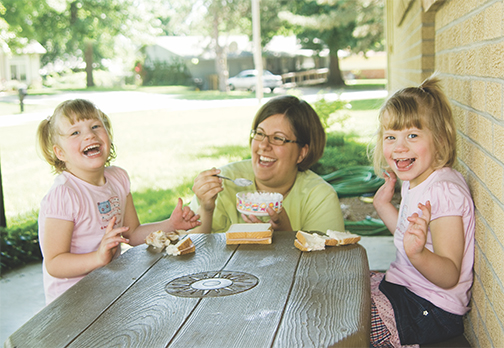
Angelman Syndrome, an uncommon genetic disorder too often misunderstood and misdiagnosed, is an all-too-serious condition involving speech impairment or lack of speech, seizures, mental and motor retardation — delightful blue eyes, a mysterious fascination with water and giggles.
Lots of giggles.
Giggles explode from the twins as they tussle on the living room carpet.
Arms and legs akimbo, they’re formidable targets in their mom’s quest to change their clothes — from smart, summer T-shirts and skirts for morning at Rainbows to bright, flowered swimsuits for an afternoon romp in the water.
Stephanie (Campbell) Headley laughs good-naturedly with her blue-eyed, 4-year-old daughters, Zoie and Baylee. The weariness in her own eyes only peeks through occasionally. Many nights, the girls don’t sleep well, and Headley, a young wife and mother of three, is up at all hours attending to them. “We’ve put a TV in their room, so I can pop in a movie. That usually works to keep them occupied,” she says. “There’s no real pattern to their sleep habits — some nights they sleep all night; others, they don’t.”
Sleep disturbance, frequent laughing, short attention span, functionally severe developmental delay, movement disorder, seizures, speech impairment or lack of speech and a fascination with water are a few of the clinical characteristics of Zoie and Baylee’s genetic disorder: Angelman Syndrome.
Named for the English doctor, Harry Angelman, who first researched it in 1965, AS is caused by abnormal functioning of the gene UBE3A, which is located within a small region on chromosome 15. This region is missing in some 80 percent of AS individuals, including Zoie and Baylee; in the other 20 percent, other causes exist for the malfunctioning gene.
“We’ve known for sure that Zoie and Baylee have Angelman Syndrome since December 2004,” Headley relates matter-of-factly, any denial or sadness or anger about their condition previously worked out in the supportive circles of family and friends — and in the giggles and hugs of her and husband Andy’s two youngest daughters. “They were about nine months old when we first became really concerned. They weren’t developing like Jenna, their big sister, did. They weren’t sitting up or holding their bottles — developmental things like that.”
Zoie and Baylee’s developmental delays led to a long, sometimes frustrating series of visits to doctors and specialists and a battery of increasingly complex diagnostic tests. After an MRI and the first of two genetic tests revealed nothing out of the ordinary, a second try at genetic testing uncovered that crucial omission on chromosome 15.
“Zoie and Baylee had just turned three,” recalls Headley, who a little more than a year after the definitive diagnosis decided, with Andy’s support, to quit her Kansas SRS job to devote full attention to their three daughters. She’s been a stay-at-home mom since February. “After we found out, we did a lot of research so we would be prepared and know how to best help Zoie and Baylee. The Angelman Syndrome Foundation provides lots of helpful information, but, compared to many other disorders, there hasn’t been that much research done and there’s still a lot of misunderstanding about AS, even in the medical community. Some as kids have been misdiagnosed with cerebral palsy, for example, or autism.”
“To have joy one must share it. Happiness was born a twin.” — Lord Byron
 As part of her family’s mission to learn as much about AS as possible, Headley jumped at the opportunity to have her mom, who works at Wichita State, take her daughters in for an evaluation at the WSU Speech-Language-Hearing Clinic, which is housed in the Hughes Metropolitan Complex and operated through the university’s venerable communication disorders and sciences department.
As part of her family’s mission to learn as much about AS as possible, Headley jumped at the opportunity to have her mom, who works at Wichita State, take her daughters in for an evaluation at the WSU Speech-Language-Hearing Clinic, which is housed in the Hughes Metropolitan Complex and operated through the university’s venerable communication disorders and sciences department.
Founded in 1934 by Martin Palmer, the speech sciences department at the University of Wichita began modestly with 12 students, but quickly grew in both student and faculty numbers, and in academic stature. A treatment and research center, the Flo Brown Memorial Laboratory, was established, and the department and the lab evolved into the Institute of Logopedics.
In 1963, the first PhD was awarded at Wichita State — in logopedics. The institute and the department became separate entities in the 1970s, with the institute growing into Wichita’s Heartspring, so named in 1993. The department underwent another name change in 1979; communicative disorders and sciences was its new moniker, today only slightly amended to communication disorders and sciences.
The department offers five academic programs (Signing Exact English certification, Bachelor of Arts in CDS, Master of Arts in speech-language pathology, Doctor of Audiology and Doctor of Philosophy in CDS) and boasts an impressive faculty, headed by professor and new chair Kathy Coufal, a specialist in child language. Faculty members Rosalind Scudder ’64/72/78, professor; Trisha Self ’84/85/91, director of clinical programs and research; Julie Scherz ’69/71/89, associate professor; and Kathy Strattman ’71/01, assistant professor, met Zoie and Baylee one January afternoon at the clinic.
“Zoie and Baylee are the first children with Angelman Syndrome I have seen in my 30-plus-year clinical career,” Scherz reports. “We were struck by the limited number of reciprocal communication interactions we were able to elicit. The twins were extremely active and did not maintain a connection with anyone else in the room for even a few seconds. On occasion, we could get them to attend to an interesting toy — or the water fountain! — but we didn’t see much turn-taking, et cetera. The ‘randomness’ of their behavior was striking; nothing seemed very purposeful. And we were particularly concerned with Zoie about the presence of what we thought were seizure behaviors.”

Inc., Zoie, at left, mom Stephanie and Baylee enjoy lunch on
the front porch of their Wichita home.
Zoie and Baylee’s mom and dad and members of their extended family had read that some 90 percent of AS children suffer from seizures, yet because of the twins’ hyperactivity, short attention spans and tremulous movements, mild seizure behavior was difficult to spot. Says Headley, “Julie was the first to say, ‘Yes, this looks like a seizure.’”
The Headleys followed up on this distressing news with yet more visits to doctors, including a neurologist who confirmed seizure activity in Zoie and later Baylee. After a period of adjustment for each of them, the twins are now being treated successfully with anti-seizure medication.
Scherz, who works primarily with individuals who have communication impairments due to neurological disorders (cerebral palsy and stroke, for example) relates, “We ‘typical’ folks take our ability to communicate so much for granted we forget what a tough, complex job it is. The most rewarding aspect of my work is helping individuals gain, or regain, a sense of the power of communication.” Strattman adds, “So much of who we are is expressed in communication. Our personality, sense of humor, the very intimate part of us that makes us unique is so tied to our ability to express ourselves to those we care about.”
Indeed, the most heartbreaking aspect of as is the severe curtailment of the ability to share thoughts and emotions.
Although there is hope that alternative communication systems (such as picture boards and a form of enhanced natural gestures) can help Zoie and Baylee express themselves, tried-and-true methods are nonexistent. In fact, clinical care plans that target almost any aspect of AS are rarer than the disorder itself.
“The problem is,” Scherz says, “there is very little information about children with AS and what to expect for them on the road ahead. What information exists is more from a medical perspective, not a clinical one. It’s frustrating not knowing how to help families in a reasonable, realistic way.”
To help alleviate this dearth of information, Scherz and Strattman are writing a proposal in hopes of obtaining an Angelman Syndrome Foundation research grant. Scherz explains, “We want to do a series of interviews with the twins’ parents, their sibling, their extended family who have been involved in their care and the professionals who have worked with them. Through this process, called ethnographic interviewing, we hope to identify basic issues of concern and a sense of what has and has not worked. We think having this in-depth information from one family with a unique situation can help professionals and other families gain a better understanding of the syndrome and its effects.”
“At the height of laughter, the universe is flung into a kaleidoscope of new possibilities.” — Jean Houston
Routine, Headley says, is important to the twins, especially to Baylee, who’s the youngest by a minute. During the school year, the Headley household’s weekday schedule is set around getting Andy off to work, Jenna to school and the twins to Rainbows United from 8:30-11:30 a.m.
There, they receive individual physical and speech therapy and other specialized attention. After the bus drops them back home, their mom makes lunch and reads, plays, watches movies or sometimes, if it was an especially rough night before, naps with them until time to pick Jenna up from school.
Keeping up with Zoie and Baylee is “challenging,” Headley admits. “But we have a great support system, including Andy’s parents and mine — and Jenna helps out a lot. People sometimes say ‘I’m sorry’ when they meet Zoie and Baylee, but I say don’t think that. They’re very good kids. They’re happy. Instead of focusing on the things they can’t do, it’s important to focus on the things they can. I get more hugs in a day than most ‘regular’ moms do. I love that; that’s the best. It’s a joy being their and Jenna’s mom.”
Jenna, who’s 9, reports, “The most fun thing about being their big sister is getting to wrestle with them. They’re fun to have for little sisters because they laugh and giggle a lot — and they love me!”
As Jenna points out, in Zoie and Baylee’s family, there is decidedly no omission of love.
WSU’s Speech-Language-Hearing Clinic: A RiteCare Facility
On this mid-spring afternoon, there are seven clients in the clinic waiting room: five women, two men, their ages ranging from young adult to senior citizen. No youngsters today, so the train set laid out on a low table is motionless and toys remain neatly aligned on their shelves in the clinic’s play area.
Housed in a suite of rooms at the WSU Hughes Metropolitan Complex, the nonprofit clinic has a client base of some 250 individuals, about half of whom seek help for hearing problems and the other half for speech-language pathologies caused by everything from genetic disorders to traumatic brain injury to stroke.
The clinic, while offering a wide range of diagnostic and therapy services to clients of all ages, also provides accredited educational experience and clinical training to graduate and post-graduate students. As a teaching clinic, the collaborative efforts of students and faculty result in the creation of "best practice" methodologies, which are then shared with others in the health and education communities.
In addition to individual and small-group services, the clinic also offers a licensed preschool program for children 2 1/2 to 5 years of age; Kaleidoscope is an integrated preschool for kids learning to communicate.
The clinic is operated through Wichita State’s venerable communication disorders and sciences department. Founded in 1934 by Martin Palmer, the original department of speech sciences at the University of Wichita began modestly with 12 students.
Palmer soon opened the Flo Brown Memorial Laboratory, a facility dedicated to the study and treatment of speech defects. By 1945, the lab and the department had evolved together into the Institute of Logopedics, named from the root words logos, meaning work, and pedia, children.
Then, after years of being fiscally and physically inseparable, the institute and the department became separate entities during the early 1970s, with the institute growing into Wichita’s Heartspring, so named in 1993.
At WSU, the name of the department was changed in 1979 to communicative disorders and sciences to better reflect the mission of its clinical and research efforts, which, despite its earlier name, had always included the evaluation and treatment of adults.
Today, by offering both off- and on-campus opportunities for practicum experiences, the CDS department carries on its long and lauded tradition of providing an academic and clinical education for students whose primary goal is to help people with communicative and hearing disorders.
Because the department’s mission meshes so well with the national cause of the Scottish Rite (helping children with speech and language disorders), in 2001 the clinic was chosen by the Kansas Scottish Rite to serve as a RiteCare Clinic.
Through this partnership, affordable speech-language services are made available to more children. Additionally, both the KSR and the Wichita Scottish Rite have proven to be steadfast and generous supporters of the clinic, the CDS department and Wichita State.
To cite only two examples, the KSR has committed $80,000 to an endowed CDS faculty development fund, and the WSR is embarking on a $5 million fundraising campaign to renovate its temple in downtown Wichita — and has designated $1 million of that fund to WSU.





